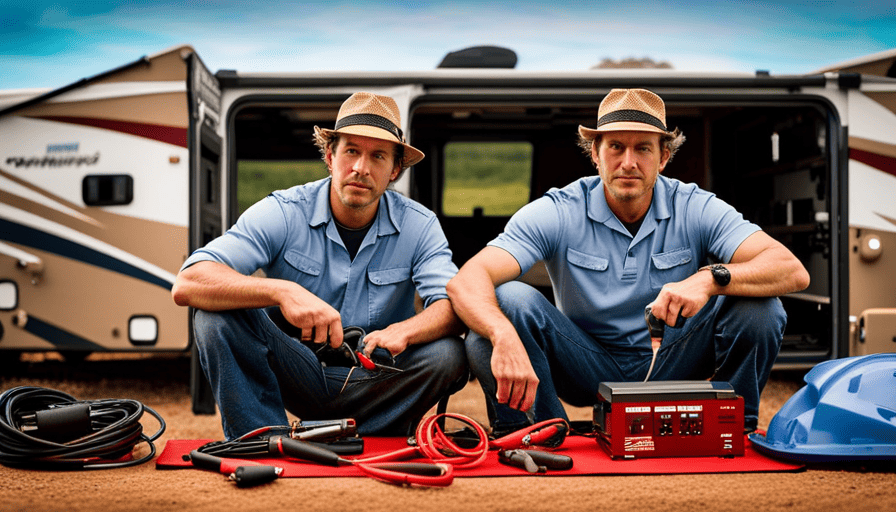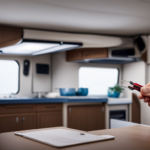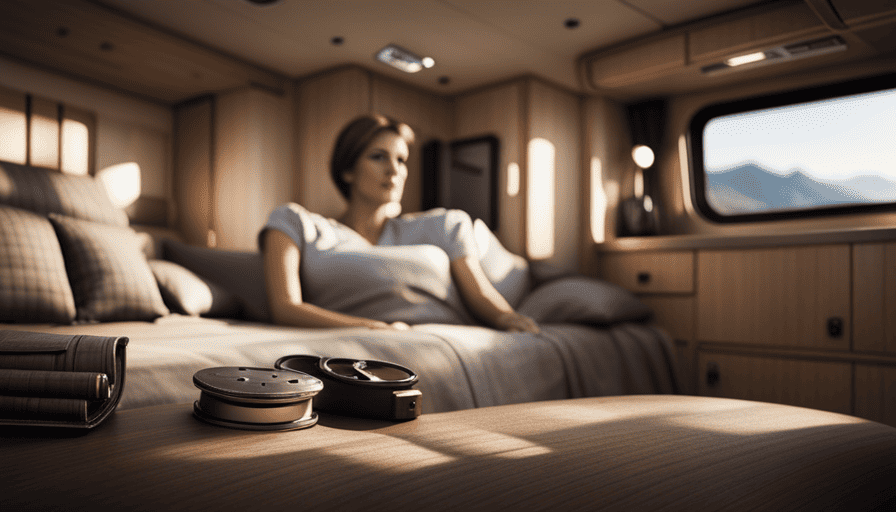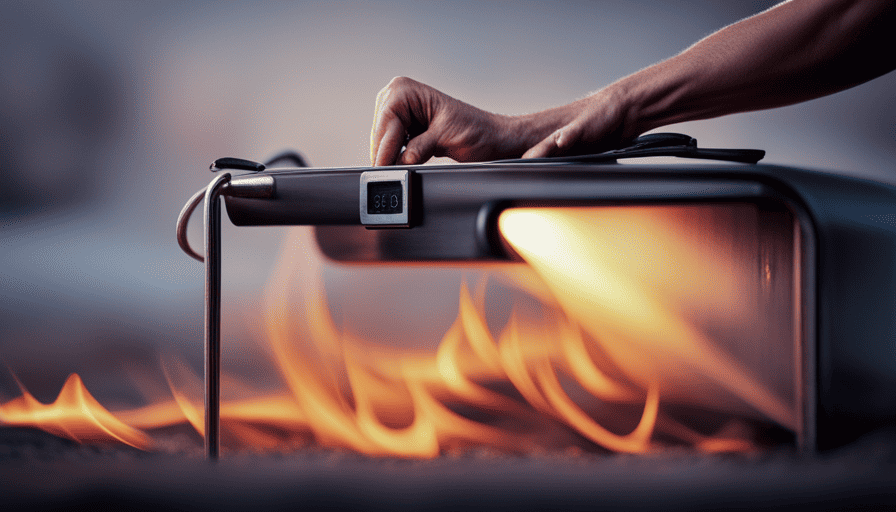When setting off on road trips in my camper, it’s crucial for me to bring the conveniences of home with me. That’s why installing a power inverter in my camper has truly revolutionized my travel adventures.
With a power inverter, I can easily convert the DC power from my camper’s battery into AC power, allowing me to run all of my electronic devices and appliances on the go.
In this article, I’ll walk you through the step-by-step process of installing a power inverter in your camper. From assessing your power needs to connecting the inverter to your camper’s electrical system, I’ll cover it all. I’ll even share some tips on how to secure and hide the wiring for a clean and professional installation.
By the end of this article, you’ll be able to enjoy the convenience of electrical power in your camper, whether you’re camping off-grid or just need a reliable source of power while on the road.
So let’s get started and dive into the world of power inverters for campers!
Key Takeaways
- Assess power needs by calculating wattage and usage time of electrical appliances and devices
- Choose an inverter size that can handle the calculated wattage
- Install the power inverter in a secure location considering power rating and wiring method
- Connect the power inverter to the battery and camper’s electrical system for powering appliances and devices
Assess Your Power Needs
Before you hit the road, it’s crucial to assess how much power you’ll need in your camper to ensure an unforgettable adventure.
To calculate power consumption, start by making a list of all the electrical appliances and devices you plan to use in your camper. Take note of their power requirements, usually measured in watts, and estimate the number of hours you’ll use each item per day. Add up the total wattage and multiply it by the number of hours to get the total watt-hours needed.
Once you have determined your power needs, it’s time to choose the appropriate inverter size. The inverter size should be based on the maximum power demand of your camper. Look for an inverter that can handle the highest wattage you calculated earlier. Keep in mind that it’s better to have a slightly larger inverter than one that is too small, as it may not be able to handle the load.
Now that you have assessed your power needs and determined the appropriate inverter size, it’s time to choose the right power inverter for your camper.
Choose the Right Power Inverter
To ensure a seamless transition from the road to relaxation, it’s crucial to select the perfect energy-transforming companion for your mobile sanctuary. Choosing the right power inverter for your needs involves two key considerations: determining the appropriate wattage and considering the inverter’s features and safety capabilities.
First, determining the appropriate wattage is essential to ensure that your power inverter can handle the electrical demands of your camper. To do this, you’ll need to calculate the total wattage of the devices you plan to power simultaneously. Make a list of all the appliances and electronics you’ll be using and their respective wattages. Add up the total wattage and choose an inverter with a capacity that exceeds this amount.
Next, it’s important to consider the inverter’s features and safety capabilities. Look for features like overload protection, short circuit protection, and low voltage shutdown. These features will help protect your devices and ensure the longevity of your power inverter.
In order to gather the necessary tools and materials for the installation process, you’ll need to consider the specifications of your chosen power inverter. This will ensure that you have everything you need to successfully complete the installation and enjoy the benefits of having a power source in your camper.
Gather the Necessary Tools and Materials
Make sure you have all the tools and materials necessary to successfully set up your mobile power source. Choosing the correct power inverter is crucial for the efficiency and safety of your camper’s electrical system. To ensure proper ventilation for the power inverter, you’ll need a drill, a jigsaw, and a vent fan. These tools will let you create a ventilation system that prevents overheating and prolongs the lifespan of your power inverter.
Start by measuring the dimensions of your power inverter and marking the area where you’ll install it. Use the drill to create a hole for the vent fan and the jigsaw to cut out the necessary opening. Place the vent fan over the hole and secure it in place. This’ll allow for proper airflow and prevent the power inverter from overheating.
Once you’ve gathered all the necessary tools and materials and have installed the ventilation system, you can proceed to the next step of disconnecting the camper’s battery. This is an important safety measure to prevent any electrical accidents while installing the power inverter.
Continue to the next section to learn how to disconnect the camper’s battery and safely proceed with the installation process.
Disconnect the Camper’s Battery
Disconnecting the camper’s battery is like severing the lifeline that powers the electrical system, ensuring a safe and secure environment for installing your mobile power source. This step is crucial to avoid any accidents or electrical mishaps during the installation process. Before starting, make sure you have the necessary tools and materials ready, including gloves, safety glasses, and a wrench.
To disconnect the battery, follow these steps:
| Step | Instructions |
|---|---|
| 1 | Locate the battery in your camper. It is usually found in the engine compartment or underneath the camper. |
| 2 | Put on your safety gear, including gloves and safety glasses. |
| 3 | Use a wrench to loosen and remove the negative (-) terminal connector from the battery. |
| 4 | Repeat the same process for the positive (+) terminal connector. |
Remember, proper battery maintenance is essential for the longevity and performance of your camper’s electrical system. Once the battery is disconnected, you can proceed to install the power inverter in a secure location. This will ensure efficient and reliable power supply from alternative sources while on the road.
Install the Power Inverter in a Secure Location
Once you’ve disconnected the battery, you can securely position the power inverter in your camper to ensure reliable and efficient access to alternative power sources while on the road. It’s crucial to choose the correct power rating for safe and effective operation. You need to consider the electrical devices you plan to use and their power requirements. Determine the total power consumption of these devices and select a power inverter with a rating that can handle that load. It’s important to note that a higher power rating will allow you to power more devices simultaneously.
Next, selecting the appropriate wiring method is essential for a successful installation. You have two main options: hardwiring or using a plug-and-play kit. Hardwiring involves connecting the power inverter directly to the camper’s electrical system. This method provides a more permanent and secure connection. On the other hand, a plug-and-play kit allows for easier installation and portability, as it involves using a cigarette lighter adapter or a similar plug to connect the power inverter to the battery.
With the power inverter securely positioned and the correct power rating chosen, you’re now ready to move on to the next step: connecting the inverter to the battery. This step will ensure that your power inverter is properly powered and ready to supply electricity to your camper.
Connect the Inverter to the Battery
To properly energize your power inverter and ensure a reliable power supply, you’ll need to establish a secure connection between the inverter and your camper’s battery. Connecting the inverter to the battery is a critical step in the installation process.
Begin by locating the positive and negative terminals on your battery. The positive terminal is typically marked with a plus sign (+), while the negative terminal is marked with a minus sign (-). Before making any connections, it’s important to ensure that the power is turned off and all electrical devices are unplugged.
To connect the inverter to the battery, start by attaching the positive cable from the inverter to the positive terminal of the battery. Secure it tightly using a wrench or socket. Next, connect the negative cable from the inverter to the negative terminal of the battery in the same manner. It’s crucial to ensure proper grounding for the inverter, so make sure the negative cable is securely connected to a metal surface on the camper’s chassis.
With the inverter now connected to the battery, you can move on to the next step of connecting it to the camper’s electrical system. This will allow you to power your appliances and devices while on the road.
Connect the Inverter to the Camper’s Electrical System
To ensure that your power inverter is fully integrated into your camper’s electrical system, the next step is to connect the inverter to the camper’s solar panels. This will allow you to harness the power of the sun and use it to charge your batteries and run your appliances while on the road.
When connecting the inverter to the camper’s solar power system, it’s important to follow the manufacturer’s instructions and guidelines. Here are the key steps to follow:
- Locate the solar panel wiring on your camper and identify the positive and negative terminals.
- Connect the positive terminal of the solar panel to the positive terminal of the inverter, and the negative terminal to the negative terminal of the inverter.
- Use appropriate connectors, such as MC4 connectors, to ensure a secure and reliable connection.
By connecting the inverter to the camper’s solar panels, you’re maximizing the efficiency and sustainability of your power system. This integration allows you to make the most of the available solar energy and reduce your reliance on external power sources.
With the inverter now connected to the camper’s electrical system, the next step is to test the power inverter to ensure it’s functioning properly and delivering the desired power output.
Test the Power Inverter
Now that your power inverter is connected to your camper’s electrical system, it’s time to put it to the test and see if it’s truly the shining star that will illuminate your adventures on the road. Imagine this: you’re parked in a remote location, surrounded by nature’s beauty, and you switch on your inverter. Suddenly, your appliances come to life like fireflies in the night, powered by the magic of the sun.
To ensure the proper functioning of your power inverter, it is essential to conduct testing procedures. Begin by checking the inverter’s display panel for any error codes or warnings. If everything appears normal, proceed to test individual appliances by plugging them into the inverter’s AC outlets. Verify if they operate smoothly and without any issues.
In case you encounter any problems during the testing phase, consider the following troubleshooting tips. First, ensure that the inverter is receiving sufficient power from the camper’s battery. Check the battery connections and voltage levels. If the inverter still fails to function correctly, consult the manufacturer’s manual for specific troubleshooting instructions.
Remember, a well-tested and functioning power inverter is crucial for a comfortable camper experience. Once you have successfully tested the inverter, we can move on to the next section about securing and hiding the wiring, ensuring a neat and organized setup.
Secure and Hide the Wiring
Once you’ve successfully tested your power inverter, it’s time to ensure a clean and organized setup by securing and hiding the wiring throughout your camper. Proper cable management is essential for a safe and efficient electrical system.
To hide the wiring, start by securing it along the walls or under the flooring using cable clips or zip ties. This will prevent any loose wires from dangling or getting in the way. Additionally, consider using wire loom or conduit to protect the cables and give them a more professional look.
When hiding the wiring, it’s important to plan ahead and consider the placement of your appliances and devices. Route the cables in a logical and organized manner to make troubleshooting or future modifications easier. You can also use wire channels or raceways to conceal the wiring behind walls or cabinets. This will give your camper a cleaner appearance and prevent any accidental damage to the wires.
For a neater setup, label the wires with tags or color-coded tape, indicating their purpose or destination. This will make it easier to identify and troubleshoot any issues that may arise in the future. Finally, don’t forget to secure any loose connections or junction points with electrical tape or wire nuts to ensure a reliable and safe electrical system.
With the wiring secured and hidden, you can now enjoy the convenience of electrical power in your camper, whether it’s for lighting, charging devices, or running appliances. So get ready to embark on your next adventure knowing that your electrical system is well-organized and ready to provide you with the power you need.
Enjoy the Convenience of Electrical Power in Your Camper
Imagine the ease and convenience of having electricity in your camper, allowing you to effortlessly power your appliances and enjoy all the comforts of home on the go. When it comes to camping power solutions, there are various portable power options available, and installing a power inverter in your camper is one of the best ways to achieve this.
A power inverter is a device that converts DC power from your camper’s battery into AC power, which is the same type of power you use at home. This means you can plug in and use your regular household appliances and electronics while camping.
To install a power inverter in your camper, start by selecting an appropriate location for the inverter. It should be easily accessible, but also secure and protected from any potential damage. Next, connect the inverter to your camper’s battery using appropriate cables and connectors. Follow the manufacturer’s instructions carefully to ensure a proper and safe installation.
Once the power inverter is installed, you can enjoy the convenience of electrical power in your camper. You can now power your appliances, charge your devices, and even use a microwave or coffee maker. It truly enhances the camping experience by providing all the comforts of home while enjoying the great outdoors.
Setting up a power inverter in your camper is a great way to have portable power options and enjoy the convenience of electrical power while camping. With the ability to power your appliances and devices, you can make your camping trips much more comfortable and enjoyable.
Frequently Asked Questions
What are the common power needs in a camper that require a power inverter?
Common power needs in a camper that require a power inverter include charging electronic devices such as smartphones and laptops, powering small appliances like microwaves or coffee makers, and running entertainment systems like TVs or gaming consoles.
The power inverter size needed depends on the wattage requirements of these devices. It’s crucial to choose an inverter with sufficient power capacity to meet these needs and ensure a smooth camping experience.
How do I determine the appropriate power inverter size for my camper?
Calculating power requirements and choosing the right inverter size for a camper is critical to ensure efficient and reliable power supply.
To determine the appropriate inverter size, you’ll need to consider the total wattage of all the devices you plan to use simultaneously. This can be done by adding up the power ratings of each device and accounting for any surge or starting wattage.
By accurately assessing your power needs, you can select an inverter that can handle the load without straining or causing damage.
Can I install a power inverter without disconnecting the camper’s battery?
No, it’s not recommended to install a power inverter without disconnecting the camper’s battery. Disconnecting the battery is necessary to ensure safety during the installation process. This step prevents any electrical current from flowing through the system, reducing the risk of electrical shock or damage to the inverter. By disconnecting the battery, you can be confident that the installation is done correctly and without any potential hazards.
What safety precautions should I take when installing a power inverter in a camper?
When installing a power inverter in a camper, safety is paramount. To ensure a secure installation, there are several precautions to take.
First, always wear protective gloves and goggles to prevent injuries.
Additionally, make sure to disconnect the camper’s battery before beginning the installation process. This eliminates the risk of electrical shock.
Finally, carefully follow the manufacturer’s instructions and guidelines to ensure a successful and safe installation.
Remember, safety first!
Are there any specific regulations or guidelines I need to follow when connecting the inverter to the camper’s electrical system?
When connecting a power inverter to a camper’s electrical system, it’s crucial to adhere to specific regulations and guidelines for a safe and efficient installation. These regulations ensure that the inverter is correctly integrated into the camper’s electrical system, minimizing the risk of electrical hazards. Following installation precautions and safety measures, such as proper grounding, fuse protection, and wire sizing, is essential to prevent damage to the inverter and ensure the safety of the camper and its occupants.
Conclusion
Well, congratulations! You’ve successfully installed a power inverter in your camper. Now, you can bask in the glory of having electrical power on your adventures.
Gone are the days of relying on nature’s whims for charging your devices or running your appliances. With your newfound electrical prowess, you can enjoy the convenience of modern technology while surrounded by the great outdoors.
So go forth, my fellow camper, and let your power inverter be the shining beacon of civilization in the wilderness. Happy camping!



















